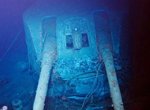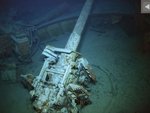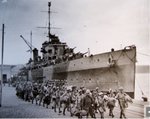Navigation
Install the app
How to install the app on iOS
Follow along with the video below to see how to install our site as a web app on your home screen.
Note: This feature may not be available in some browsers.
More options
You are using an out of date browser. It may not display this or other websites correctly.
You should upgrade or use an alternative browser.
You should upgrade or use an alternative browser.
Mystery ends in Australian WWII disaster
- Thread starter Colin1
- Start date
Ad: This forum contains affiliate links to products on Amazon and eBay. More information in Terms and rules
More options
Who Replied?vikingBerserker
Lieutenant General

Great info Colin.
RabidAlien
1st Lieutenant
 Now they can rest, knowing their story has been told.
Now they can rest, knowing their story has been told.ccheese
Member In Perpetuity
I'm certain a lot of families will finally have closure. :Salute:
Charles
Charles
Great to see closure for the families. 

syscom3
Pacific Historian
Great Story!
Soundbreaker Welch?
Tech Sergeant

To all the brave sailors that died, a tragic fate.
ToughOmbre
Senior Master Sergeant
Hopefully, some closure for the families.
To the crew of the Sydney.....

TO
To the crew of the Sydney.....

TO
Thorlifter
Captain
(Aug. 12) -- The Australian cruiser met the disguised German vessel in the waters off western Australia two years after the two became enemies in World War II.
The Australian ship approached, trying to determine whether the vessel was friendly. It wasn't.
The wreckage of the HMAS Sydney, found off Western Australia in March 2008, has helped settle a question that has haunted Australia for decades: How did the cruiser go down in 1941, and why did all 645 on board die? A new report said the Sydney's captain got too close to the German raider that sank with it in a fierce battle.
A Haunting Episode in History
The wreckage of the HMAS Sydney, found off Western Australia in March 2008, has helped settle a question that has haunted Australia for decades: How did the cruiser go down in 1941, and why did all 645 on board die? A new report said the Sydney's captain got too close to the German raider that went down with it in a fierce battle.
What resulted was Australia's worst naval disaster: the sinking of the Australian ship and the loss of its entire crew of 645. The wreckage wasn't found until last year, leading to decades of conspiracy theories about what actually happened.
On Wednesday a long-awaited report on the sinking of the HMAS Sydney ended the mystery that began when it met its fate on Nov. 19, 1941.
Made to look like a cargo ship, the German vessel was in fact a military raider that fired on the Australians when they got close. The Sydney fired back and, in the end, both ships went down.
More than 300 of the sailors on board the German vessel, the HSK Kormoran, survived. But because they were the only witnesses to the disaster, some doubted their accounts, leading to various theories about the real fate of the Sydney.
After the wrecks of both ships were located in March 2008, an Australian commission began an inquiry to formally close the book on the loss of the Sydney.
The results confirm the accounts provided by the German sailors.
They said the Sydney closed in on the Kormoran until it was parallel with the German ship, little more than 1,000 yards away.
"Sydney obviously thought the ship was friendly and was taken by surprise when, after she asked what she believed to be (a friendly ship) to give her secret call sign, the response was a number of salvos that destroyed Sydney's bridge and amidships superstructure and a torpedo strike that crippled the ship and her forward guns," the report said.
The Sydney had given up its tactical advantage of speed and armaments by getting so close to an unknown vessel, the report said.
While that may have been an error of judgment by the Australian captain, Joseph Burnett, the report accepted that other factors -- which may never be known -- influenced his decision.
"It can never be known what matters were, in fact, operating in Capt. Burnett's mind when he decided to take the Sydney to the position described. Nor can it be known what advice, if any, he sought from or was given by other officers on the bridge," the report says.
"What is known, however, is that, in trying to identify the sighted ship, Capt. Burnett was performing his duty as a commanding officer."
The German ship inflicted "enormous damage" on the Sydney during a battle that is believed to have lasted about 35 minutes and left 70 percent of the Sydney's crew dead or incapacitated, said Cmdr. Jack Rush, the lawyer who presented the evidence gathered by investigators to a commission of inquiry led by a retired judge.
It is likely that Burnett, the navigator, and all of the Sydney's senior officers were taken out on the first salvo, Rush said.
A torpedo tore into the Sydney's bow, flooding the forward end of the ship, while the Kormoran fired an estimated 87 rounds from its 15-cm (5.9-inch) guns into the Australian cruiser. The Sydney limped away and sank sometime between 2 hours to 4 1/2 hours later, Rush said.
During the battle, however, the Kormoran itself was hit by an Australian shell that damaged its engines and set the vessel ablaze. With hundreds of mines aboard, its captain ordered the crew to abandon ship, fearing the fire would set those off. Charges were set and the ship was scuttled.
About 80 of the Kormoran's crew of nearly 400 were lost.
A search began only five days after the battle, when the Sydney failed to return to port in Fremantle. And an 11-day delay by Australia's government in announcing the ship's loss fueled what a 1999 parliamentary report called "a proliferation of theories" about the fate of the crew -- that the ship was actually sunk by a Japanese submarine, that survivors were machine-gunned in the water or that the government hid bodies after they washed up on the beach.
The commission thoroughly investigated all the theories and speculations surrounding the disaster and found no substance in any of them, said Terence Cole, president of the commission.
Researchers found the Sydney's wreckage in the Indian Ocean, about 207 km (128 miles) off Australia's west coast.
The commission was appointed in May 2008 and began its inquiry in January.
"For a long time our nation has struggled to understand how our greatest maritime disaster occurred. The unanswered questions have haunted the families of those brave sailors and airman that never came home," Air Chief Marshal Angus Houston, the chief of the Australian Defence Force, said in a written statement.
The Australian ship approached, trying to determine whether the vessel was friendly. It wasn't.
The wreckage of the HMAS Sydney, found off Western Australia in March 2008, has helped settle a question that has haunted Australia for decades: How did the cruiser go down in 1941, and why did all 645 on board die? A new report said the Sydney's captain got too close to the German raider that sank with it in a fierce battle.
A Haunting Episode in History
The wreckage of the HMAS Sydney, found off Western Australia in March 2008, has helped settle a question that has haunted Australia for decades: How did the cruiser go down in 1941, and why did all 645 on board die? A new report said the Sydney's captain got too close to the German raider that went down with it in a fierce battle.
What resulted was Australia's worst naval disaster: the sinking of the Australian ship and the loss of its entire crew of 645. The wreckage wasn't found until last year, leading to decades of conspiracy theories about what actually happened.
On Wednesday a long-awaited report on the sinking of the HMAS Sydney ended the mystery that began when it met its fate on Nov. 19, 1941.
Made to look like a cargo ship, the German vessel was in fact a military raider that fired on the Australians when they got close. The Sydney fired back and, in the end, both ships went down.
More than 300 of the sailors on board the German vessel, the HSK Kormoran, survived. But because they were the only witnesses to the disaster, some doubted their accounts, leading to various theories about the real fate of the Sydney.
After the wrecks of both ships were located in March 2008, an Australian commission began an inquiry to formally close the book on the loss of the Sydney.
The results confirm the accounts provided by the German sailors.
They said the Sydney closed in on the Kormoran until it was parallel with the German ship, little more than 1,000 yards away.
"Sydney obviously thought the ship was friendly and was taken by surprise when, after she asked what she believed to be (a friendly ship) to give her secret call sign, the response was a number of salvos that destroyed Sydney's bridge and amidships superstructure and a torpedo strike that crippled the ship and her forward guns," the report said.
The Sydney had given up its tactical advantage of speed and armaments by getting so close to an unknown vessel, the report said.
While that may have been an error of judgment by the Australian captain, Joseph Burnett, the report accepted that other factors -- which may never be known -- influenced his decision.
"It can never be known what matters were, in fact, operating in Capt. Burnett's mind when he decided to take the Sydney to the position described. Nor can it be known what advice, if any, he sought from or was given by other officers on the bridge," the report says.
"What is known, however, is that, in trying to identify the sighted ship, Capt. Burnett was performing his duty as a commanding officer."
The German ship inflicted "enormous damage" on the Sydney during a battle that is believed to have lasted about 35 minutes and left 70 percent of the Sydney's crew dead or incapacitated, said Cmdr. Jack Rush, the lawyer who presented the evidence gathered by investigators to a commission of inquiry led by a retired judge.
It is likely that Burnett, the navigator, and all of the Sydney's senior officers were taken out on the first salvo, Rush said.
A torpedo tore into the Sydney's bow, flooding the forward end of the ship, while the Kormoran fired an estimated 87 rounds from its 15-cm (5.9-inch) guns into the Australian cruiser. The Sydney limped away and sank sometime between 2 hours to 4 1/2 hours later, Rush said.
During the battle, however, the Kormoran itself was hit by an Australian shell that damaged its engines and set the vessel ablaze. With hundreds of mines aboard, its captain ordered the crew to abandon ship, fearing the fire would set those off. Charges were set and the ship was scuttled.
About 80 of the Kormoran's crew of nearly 400 were lost.
A search began only five days after the battle, when the Sydney failed to return to port in Fremantle. And an 11-day delay by Australia's government in announcing the ship's loss fueled what a 1999 parliamentary report called "a proliferation of theories" about the fate of the crew -- that the ship was actually sunk by a Japanese submarine, that survivors were machine-gunned in the water or that the government hid bodies after they washed up on the beach.
The commission thoroughly investigated all the theories and speculations surrounding the disaster and found no substance in any of them, said Terence Cole, president of the commission.
Researchers found the Sydney's wreckage in the Indian Ocean, about 207 km (128 miles) off Australia's west coast.
The commission was appointed in May 2008 and began its inquiry in January.
"For a long time our nation has struggled to understand how our greatest maritime disaster occurred. The unanswered questions have haunted the families of those brave sailors and airman that never came home," Air Chief Marshal Angus Houston, the chief of the Australian Defence Force, said in a written statement.
Attachments
Ferdinand Foch
Staff Sergeant
 May those brave sailors rest in peace. Hopefully, this can bring closure to the remaining relatives.
May those brave sailors rest in peace. Hopefully, this can bring closure to the remaining relatives.Users who are viewing this thread
Total: 1 (members: 0, guests: 1)
Similar threads
- Replies
- 0
- Views
- 691



